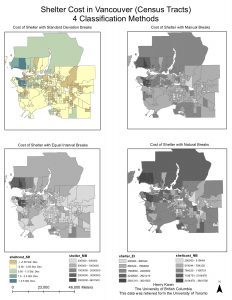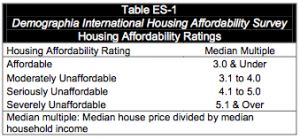1. Quantitative Data Classification

Census tracts give detail about a certain district within Metro Vancouver. Each area within a census tract contains data within the district to analyze. However, Desminiation areas is used to represent for the entire city. Since dissemination areas analyze the entire city, data may be suppressed in different parts of the city due to data regulations by Statistics Canada so that the city can be broadly represented. This allows data to be available for the entire city but inaccurate data for certain regions of the city.
As a journalist, I will choose natural breaks as the classification method for the housing cost in Metro Vancouver since we can show the large discrepancy among the different regions of Vancouver. Moreover, it will help me emphasize the areas that are most and least expensive in Vancouver and would help prove my argument.
If I am a real estate agent, I would use equal interval to prepare a presentation for prospective home buyers near UBC. Using equal interval is important since it presents UBC as affordable. However, other classifications would show that UBC is severely unaffordable compared to other areas of Vancouver. This is important as my objective as a real estate agent is to attract potential home buyers in an extremely competitive market in Vancouver. There are ethical implications since prospective home buyers will not know how much home prices in UBC will deviate from the standard.
Yes there are ethical implications for using different classification methods particularly the equal interval classification near UBC since it deceives customers into thinking that home prices are cheap at UBC.
2. Data Uncertainty
DAs in the Vancouver Eastside have zeros since some of these shelters are run by donations and therefore there is negligible costs in this area. Moreover, it is possible that the people in this area do not participate in the Census every five years. It may also be due to the complexity of the area and statistics Canada has therefore suppressed data for the Downtown Eastside
Census tracts give detail about a certain district within Metro Vancouver. Each area within a census tract contains data within the district to analyze. However, Desminiation areas is used to represent for the entire city. Since dissemination areas analyze the entire city, data may be suppressed in different parts of the city due to data regulations by Statistics Canada so that the city can be broadly represented. This allows data to be available for the entire city but inaccurate data for certain regions of the city.
3. Cost of Housing
a) Cost of shelter

Shelter cost represents the housing cost in the City of Vancouver and the City of Montreal. Some of the problems with this variable include extraneous data that must be excluded from the dataset. For example, a number of census tracts and desinimation tracts were neglected since there was no data in some regions since people do not participate in the Census every five years.
b) Housing affordability
What is affordability measuring, and why is it a better indicator of housing affordability than housing cost alone?
Affordability is measuring the nominal value of a house with an individual’s income. This is a better indicator of housing affordability than housing cost alone since the cost of housing and an individual’s income varies across the country. ITs important to note that while it may be unaffordable to own a home in Vancouver, it ay be easy for other individuals since they may be earning a higher income.
What are the housing affordability rating categories?

The housing affordability rating categories are Affordable (3.0 & under), Moderately Unaffordable (3.1 – 4.0), Seriously Unaffordable (4.1 – 5.0), Severely Unaffordable (5.1 & over). This rating system can be trusted since it is used by the United Nations and other governmental organizations and educational institutions.
Is affordability a good indicator of a city’s ‘livability’?
Affordability is a good indicator of a city’s livability since it is the sum of factors that equal the quality of life. Many of these factors include economic, social, and educational stability. Affordability is one of many factors that determine livability. According to the data retrieved from the University of Toronto, people in Montreal make more money and the value of an average home is less than Vancouver. We can extrapolate from the data that it is much easier to live in Montreal due to the low cost of housing and high income individuals make. However, this does not mean Vancouver is not livable. Although the majority of income for Vancouver residents go into housing, people still manage to maintain a high quality of life through other avenues through renting apartments with others.